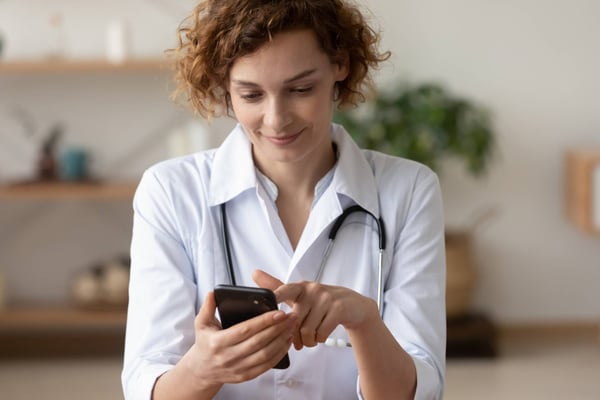Livewell Southwest has set an example on how to go digital in an exemplary way. This time, we spoke with Jen Fox, a dedicated Specialist Community Public Health Nurse, Health Visitor, and Infant Feeding Lead about how she uses Livewell Connect, the healthcare provider’s virtual clinic powered by Visiba Care, how working exclusively digitally has changed her everyday life, and the benefits of the right platform. Jen Fox is regularly meeting new parents and their children, and she has a remarkable attitude and passion for her job –in this story, she puts the digital lens on.
What do you do at Livewell Southwest? What is an average day like for you?
I am a Health Visitor, Specialist Public Health Nurse. As a Health Visitor, I visit children between the ages of 0-five-years-old. We offer five core contacts: Antenatal contact in pregnancy, new birth contact to babies between 10-14 days, six to -eight -week review, a one-year developmental review, and a 24-30-month development review. That’s our basic structure and then we add in more support visits as needed. It’s very flexible for families – we are there to support children and families so right at the very end, they’re bright, shiny, sparkly adults. It is a great job!
I am also one of four Infant Feeding Leads at Livewell and we have all had additional training. We run training for Health Visiting; we work collaboratively across Plymouth with volunteers, midwives and children’s centres to offer a broad support package for breastfeeding.
There is no average day! It varies enormously. In current circumstances, life has been completely turned upside down, so I definitely have a new normal. I do my contacts spread over the day – I do as many of them as I can via Livewell Connect. Some people don’t want to do it and that’s ok; I roll with that. If they say no to antenatal, I try to use it for the new birth visit because I love seeing the babies! When we get back out, I can see how they have changed and grown, and a really big part of my job is watching the babies’ progress. I might start with two visits in the morning and two visits in the afternoon, writing records, dipping in and out of duty.
“People were talking about which digital platform they are using and how they had security issues; I thought that this is great, because we don’t have to think about this issue now: It is all secure, it is easy to use – problem solved”
How is your organisation using Visiba Care?
We are using the video consultation option. Outside communication is all done by phone and text. I can set an appointment so quickly that when someone needs a prescription or a feeding review, I can set it up in a spare half-an-hour and rapidly assess the baby, the mum, and what’s going on and write the prescription if necessary. Even though we are only using the video consultation function, we use it the best we can – and I have seen that across services at Livewell.
Let’s go back to the first day you heard about Livewell Connect. What was your first reaction when you heard that your organisation is going digital?
I had an invite for training via email in late January and I couldn’t join at that time. Then we went into lockdown so face-to-face training was cancelled. Luckily, Mike Oliver (Project Manager at Livewell Southwest) brought out an online training package and that’s what I did. That’s when I realised its potential; there was so much scope there.
In professional forums, on Facebook groups for Health Visitors, people were talking about which digital platform they are using and how they had security issues; I thought that this is great, because we don’t have to think about this issue now, it is all secure, it is easy to use – problem solved, excellent!
How have your routines and your workday changed after Livewell Connect?
I can do an awful lot more in the day – That is one of the overwhelming things of working from home and using Livewell Connect. I can do more visits in a day because I am not travelling in-between. I also find my visits more direct; I am getting them done not massively quicker – but quicker than before. Normally, my new birth visit would be about an hour long and I am now doing it in about 45 minutes. That’s pretty much across the spectrum of our contacts. Efficiency-wise, it’s super – and you still get that personal interface which I really like.
You get a different side of people, because you are not in their living room talking to them – it’s slightly different. It’s not necessarily a bad different, it’s just different.
Signposting is a really interesting case. I think you’re taking more in from this platform than you do on the telephone. In Livewell Connect, when you have that interaction, the flow, the eye contact and being able to elaborate and gesture, it comes across so much better. I’ve had people refer to the conversations, as in ‘what was that thing you were telling me about?’ and ‘what was that website called again?’, so I think it has enabled more signposting. You take on more when you have that face-to-face dialogue.
Do you get different types of visits?
My caseload is diverse, but I work in an area with a high amount of deprivation and that obviously brings its own challenges, particularly in the safeguarding arena. But being able to see into someone’s home and making a better assessment using Livewell Connect is great. Some of our families have not had data to use or wi-fi, which meant that I haven’t been able to use it. But I have been pleasantly surprised at how many have been able to use it and have said ‘This is actually really good, Jen, I’m glad we have been able to do this’.
With what’s going on in the world right now, having that face-to-face dialogue with someone that is not over the phone and look in their eyes, I really value that.
-Jen Fox, Livewell Southwest
Have you had any feedback or comments from the patients?
Where I’ve seen the biggest difference is with the new birth. When mums have had babies in this crazy, crazy time, they haven’t had family support because family haven’t been allowed to visit; they don’t have the peer support they get from going to the clinic or a baby group; they are really isolated, and they have found seeing me really valuable. It’s been great for me as well, because I feel like I am actively supporting these families and it is really important. I do a lot of arranging through my mobile which also gives an extra dynamic. Often, I follow up my Livewell Connect contacts with just a text summarising what we talked about, maybe some signposting with useful information to build on what we talked about.
The other group of people that have found it really valuable is when I go back to my one-year reviews. They are so excited to show off their babies to me! I haven’t seen them since they were eight- weeks -old – I might have seen them in the clinic or in support phone calls but not necessarily face-to-face. When I see them again at nine months, parents tell me ‘Jen, look what they are doing!’ and they are so pleased to be able to show me how their baby has developed and grown. It’s just magic, I love it – it’s a proper privilege.
One of the biggest success factors of digital transformation in healthcare is the patient experience. Read more about how Visiba Care works for patients and our collaboration with our patient panel.
What other applications do you see with Visiba Care?
What my colleagues and I have looked at is running a baby group through Livewell Connect. We were looking at having a six-week course with six parents and one or two healthcare professionals leading the group – talking about health and wellbeing, play, communication, introduction of solid foods, and some baby massage sessions.
I have also used Livewell Connect with an interpreter and it was great! I actually felt less awkward than I usually do. It felt so fluid, there’s less interference and less talking over each other, because you have to wait for the other person to finish. It worked really well, everyone was engaged, I’m really pleased. There are definitely things to build on there.
What benefits do you see with healthcare going digital – particularly during the pandemic?
Accessibility is really important – I can’t face-to-face with people for personal reasons so having this has been absolutely amazing. I can continue my role and not put myself in any danger – but I can still give really good service to my families and enable them to help their babies thrive, because that’s what they deserve.
It doesn’t matter if COVID-19 is going on; the babies born during this time and the new mums, whether they are a new mum for the first or the third time, are still so vulnerable and they deserve the support to be able to nurture themselves and their babies. Being able to share public health information this way is just amazing. With what’s going on in the world right now, having that face-to-face dialogue with someone that is not over the phone and look in their eyes, I really value that – I cannot offer any physical reassurance, but I can be there and support people.
Also, at Livewell, we take cybersecurity very seriously. Public Health England has issued advice about digital security and how to use digital platforms securely while you are making the most of your contact. There has been a lot of talk about conventional video and messaging platforms. There’s a lot of different platforms being used nationwide and there is a lot of concern about security and how that can be made safe. The fact that this worry has been taken away is great ¬– because I know that it is as safe as it can be!
Visiba Care is CE marked and compliant with the NHS Data Security and Protection Toolkit. Read more about security in Visiba Care.
Livewell Southwest has had a remarkable response to the pandemic and you have been so quick to adapt with digital transformation. What do you think is the success factor?
I think Livewell’s response to this crisis, and the ability to transform and evolve has been phenomenal across all levels of the organisation. We are all very passionate about providing the best possible service and I guess that comes from the bottom to the top. It must have taken a big leap of faith for someone to say ‘We need a digital platform. Let’s see if we can make it work’. And they have done it and it’s great!
I really hope that post-COVID we can continue using the same effect. I’m really looking forward to going back into households and having that physical connection with my families, but I don’t see losing Livewell Connect – I think it’s really valuable. We do not know how our service will look, it may be that we can continue doing the antenatal and the six to eight weeks contacts with the platform and just carry it forward: when we get calls from parents who would like to talk to us about, for example, behaviour, then we can quickly set it up in the Livewell Connect platform and talk to them face-to-face about it, see how we can support them.
If you could give some advice to anyone just starting with digital healthcare or is reluctant to start, what would it be?
I’ve spoken to people who have been less reluctant to use the platform, I can see where they are coming from and I know that they may find technology daunting, but I just say: It’s really easy – It’s so easy! It’s such a well-designed platform, it’s intuitive and it just works. So just give it a go!


